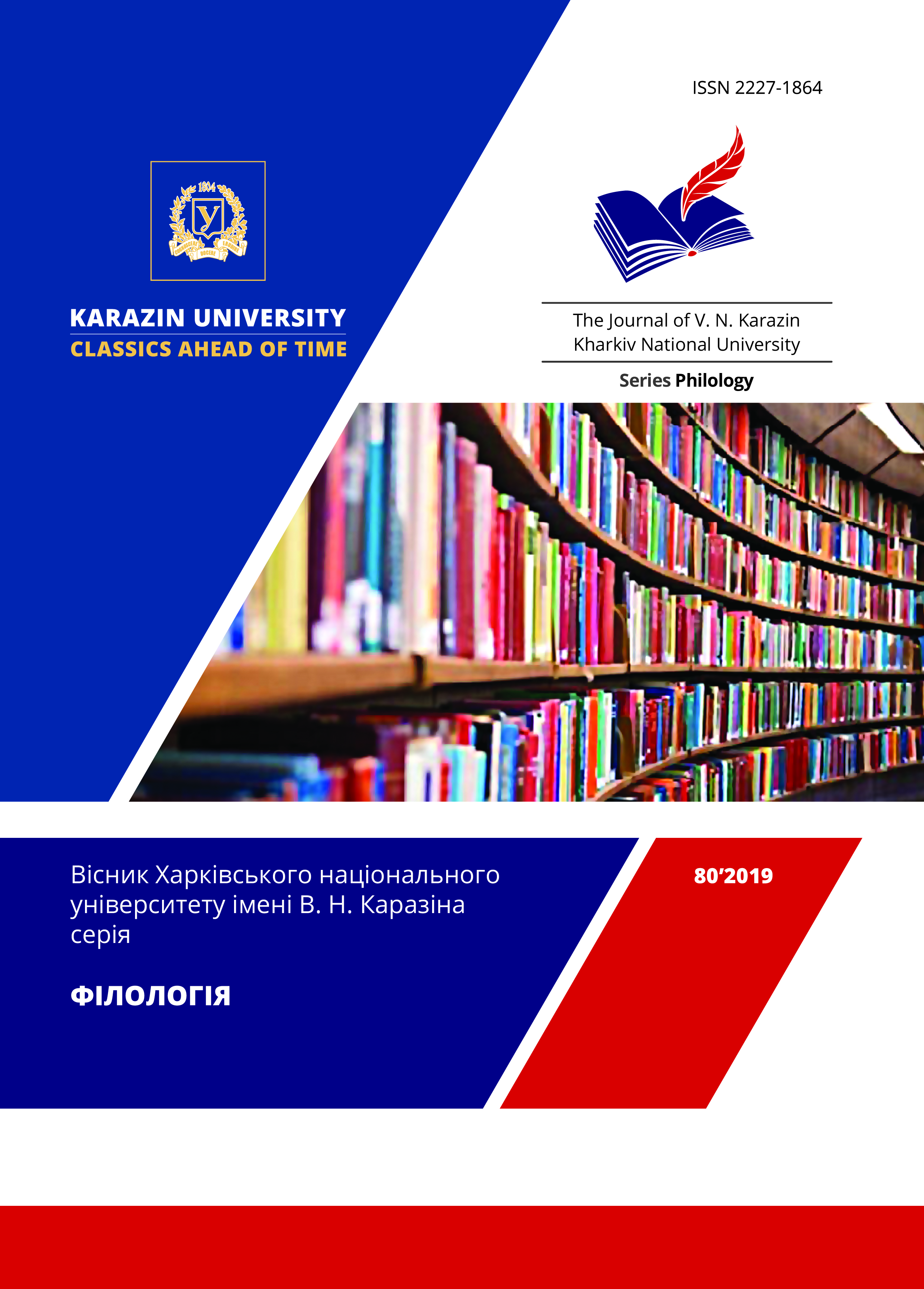Semantics and functioning of epithets for the designation of the wreath in Ukrainian calendar ritual poetry
Abstract
Considerable attention to the study of specific Ukrainian folk oral literature, observed recently led to the need for linguistic exploration of calendar ritual songs, because they most clearly record the echoes of the past and at the same time fix the peculiar changes caused by modern civilization processes. The folk poetry epithets are a conceptually important component of the artistic structure of folk works, including calendar-ritual poetry, as they relate to all the main images depicted in the songs. In the attributive space of calendar-ritual texts, the basic features of the outlook of the people are coded, as well as the meanings necessary for understanding the reconstruction of the mythological model of the Ukrainian world.
Wreath is a ritual object that appears in all calendar ritual genres and has a wide range of epithets. It is determined that the names of plants are the most productive attributives for the designation of the wreath. This is due to the ritual practice of making wreaths from certain plants, endowed with symbolic semantics. Instead, epithets related to the names of jewels and express the idea of value are later in origin. It is observed that among the analyzed attributives, those whose have the positive evaluative component in the semantic structure are predominant. This is due to pragmatic studied texts, the purpose of ritual practices, mainly to the preservation, enhancement and production of important and useful things for person, and an overall positive reflection of the symbol of the wreath in the folk tradition. Attention is drawn to rarely used, but symbolically spacious epithets, the analysis of which contributes to the conceptualization of individual fragments of the world's mythological model.
Consequently, the epithet characteristic of the wreath as a ritual object depends on the subject of the text, the speaker's orientation on the appropriate speech strategy to achieve the desired goal, as well as on the peculiarities of the mythopoetic model of the world. Epithets of the autumn-winter cycle are mostly secondary, transposed both from texts of spring-summer songs, and borrowed from the wedding ritualism of Ukrainians.
Downloads
References
Botsyakovskyy, V. (1894). Vesnyanky, petryvky y kupalʹnye pesny. Zhivaya starina, (1), 83–89.
Byarkovich, T. (2015). Pesenna-hulʹnyavyya dzei peryyadu sontsavarotu ŭ étnamuzychnay tradytsyi belarusaŭ. Minsk: Belaruskaya dzyarzhaŭnaya akadémiya muzyki.
Vasylʹkevych, H. (2004). Svyatoyuriyivsʹka narodnopoetychna tvorchistʹ: problema semantyky i zhanrovoyi spetsyfiky. Аvtoreferat dysertatsiyi (Filolohiya). Lʹvivsʹkyy natsionalʹnyy universyte imeni Ivana Franka, Ukrayina.
Vynohradova, L. Zymnyaya kalendarnaya poézyya zapadnykh y vostochnykh slavyan: Henezys y typolohyya kolyadovanyya. Moskva: Nauka.
Hnatyuk, V. (Ed.). (1909). Hayivky. Lʹviv: druk. Naukovoho t-va im. Shevchenka.
Holovatskyy, YA. (Ed.). (1878) Narodnye pesny Halytskoy y Uhorskoy Rusy. Moskva: Yzd-vo Ymp. Obshch-va Ystoryy y Drevn. Ross. pry Mosk. un-te.
Hrytsenko, O. (2015). Etyketni epitety ta yikh stylistychni mozhlyvosti v movi ukrayinsʹkoyi narodnoyi liryky. Visn. Zaporizʹkoho nats. un-tu, 2, 204–211.
Hrushevsʹkyy, M. (1993). Istoriya ukrayinsʹkoyi literatury (Vol. 6). Kyyiv: Lybidʹ.
Hura, A. (2011). Brak y svadʹba v slavyanskoy narodnoy kulʹture: semantyka y symvolyka. Moskva: Yndryk.
Danylyuk, N. (2010). Poetychne slovo v ukrayinsʹkiy narodniy pisni. Lutsʹk: Volyn. nats. un-t im. Lesi Ukrayinky.
Kotsura V., Potapenka, O., & Kuybidy, V. (Eds.). (2015). Entsyklopedychnyy slovnyk symvoliv kulʹtury Ukrayiny. Korsunʹ-Shevchenkivsʹkyy: FOP Havryshenko V. M.
Melʹnychuk, O. (2012). Etymolohichnyy slovnyk ukrayinsʹkoyi movy (Vol. 6). Kyyiv: Naukova dumka.
Dey, O., & Humenyuk, A. (Eds.). (1963). Ihry ta pisni: Vesnyano-litnya poeziya trudovoho roku. Kyyiv: AN URSR.
Kovalʹ, H. (2014). Kolir yak oznaka obrazotvorennya v kalendarno-obryadoviy poeziyi. Narodoznavchi zoshyty (Seriya filolohichna), 4, 733–740.
Hnatyuk, V. (Ed.). (1914). Kolyadky i shchedrivky. (Vol. 2). Lʹviv: druk. Naukovoho t-va im. Shevchenka.
Dey, O. (Ed.). (1965). Kolyadky ta shchedrivky: Zymova obryadova poeziya Kyyiv: Naukova dumka.
Kharchyshyn, O. (Ed.). (1914). Narodna pisennistʹ pidlʹvivsʹkoyi Zvenyhorodshchyny. Lʹviv: In-t narodoznavstva NANU, 2005.
Penʹkova, O. (2013). Tradytsiya kupalʹsʹkoho vinkopletennya v Ukrayini: istoriya ta transformatsiya v druhiy polovyni XX st. Novi storinky istoriyi Donbasu, 22, 255–268.
Potebnya, A. (1883–1887). Obyasnenyya malorusskykh y srodnykh narodnykh pesen. (Vol. 1). Varshava: Typ. Zemnevycha y Moakovskoho.
Rybakov, B. (1981). Yazychestvo drevnykh slavyan. Moskva: Nauka.
Sabadosh, I. (2014). Istoriya ukrayinsʹkoyi botanichnoyi leksyky (XIX – pochatok XX st.). Uzhhorod: Uzhhorodsʹkyy nats. un-t.
Ahapkyna, T. & Tolstoy, N. (1995–2004) Slavyanskye drevnosty: étnolynhvystycheskyy slovarʹ (Vol. 1, 2, 3). Moskva: Mezhdunarodnye otnoshenyya.
Bilodid, I. (Ed.). (1973). Slovnyk ukrayinsʹkoyi movy: v 11 t. Kyyiv: Nauk. Dumka.
Slyusareva, O. (2006). Epitetyka ukrayinsʹkykh vesilʹno-obryadovykh pisenʹ (strukturno-semantychnyy i funktsionalʹnyy aspekty). Аvtoreferat dysertatsiyi (Filolohiya). Kharkiv: KHNU imeni V. N. Karazina, Ukrayina.
Tarnavsʹkyy, R. (2015). Obzhynkovyy vinok v obryadovosti volynyan: zahalʹnoukrayinsʹki rysy ta lokalʹna spetsyfika. Materialy do ukrayinsʹkoyi etnolohiyi, 14, 65–74.
Dey, O. (1974). Ukrayinsʹki narodni pisni v zapysakh Zoriana Dolenhy-Khodakovsʹkoho (z Halychyny, Volyni, Podillya, Prydnipryanshchyny i Polissya. Kyyiv: Naukova dumka.
Filon, M. (1999). Mifolohema «haynoye panya» v ukrayinsʹkykh kolyadkakh. Visnyk Kharkivsʹkoho universytetu imeni V. N. Karazina (Filolohiya), (538), 42–51.
Chubynskyy, P. (1872). Materyaly y yssledovanyya étnohrafychesko-statystycheskoy ékspedytsyy v Zapadno-Russkyy kray. Sankt-Peterburh: Typ. Bezobrazova.
Hrynchenko, B. (1899). Etnohrafycheskie materialy, sobrannye v Chernyhovskoy y sosѣdnykh s ney huberniyakh. (Vol. 3). Chernyhov: Typ. Hub. Zemstva.
Yankovsʹka, ZH. (2011). Solyarna symvolika v ukrayinsʹkiy kulʹturniy tradytsiyi: symvol vinka. Naukovyy visnyk Uzhhorodsʹkoho un-tu (Filolohiya), (26), 164–169.




